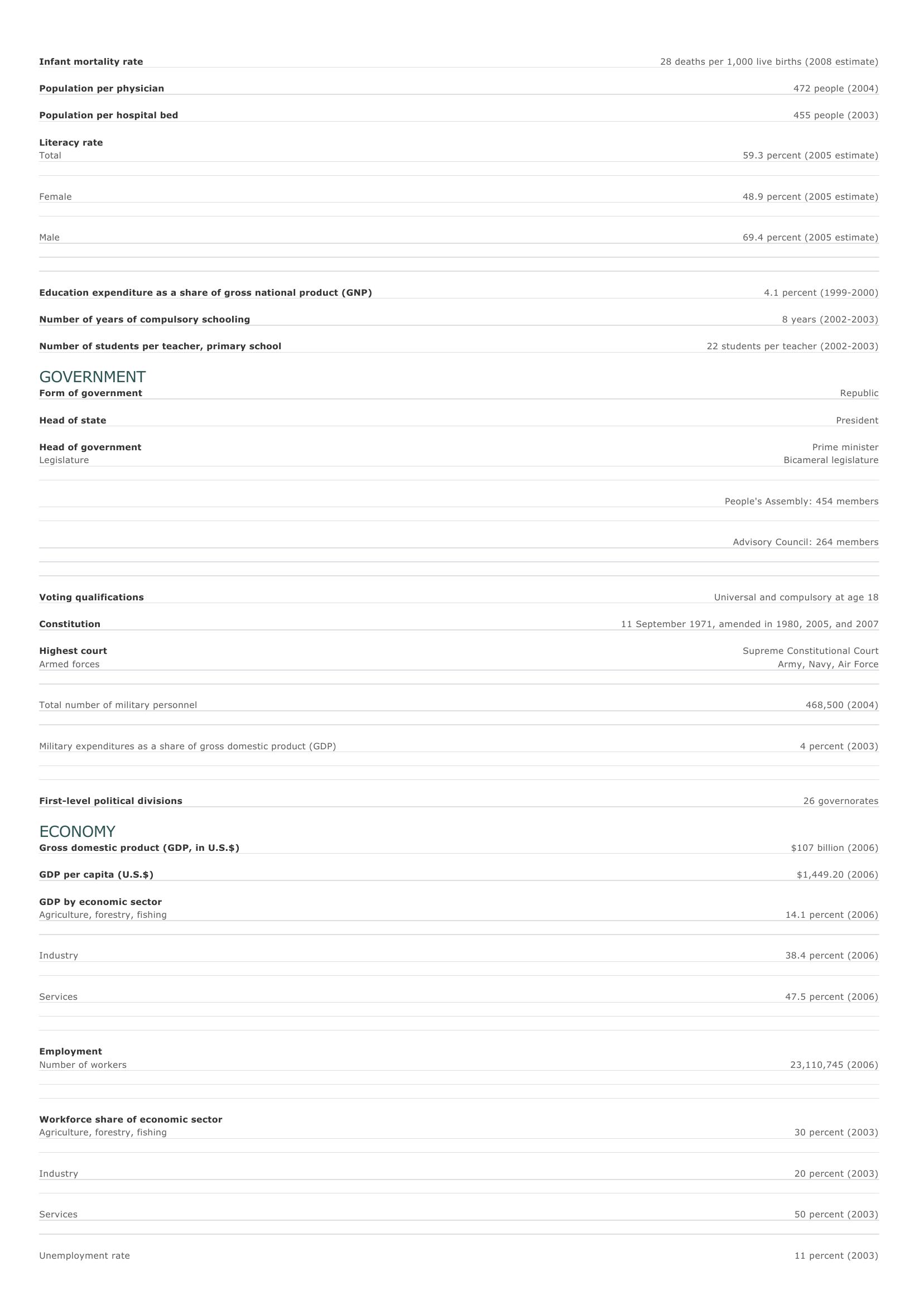Egypt Facts and Figures. BASIC FACTS Official name Capital Area Arab Republic of Egypt Cairo 997,739 sq km 385,229 sq mi PEOPLE Population 81,713,517 (2008 estimate) Population growth Population growth rate 1.68 percent (2008 estimate) Projected population in 2025 103,573,056 (2025 estimate) Projected population in 2050 127,563,256 (2050 estimate) Population density 82 persons per sq km (2008 estimate) 213 persons per sq mi (2008 estimate) Urban/rural distribution Share urban 42 percent (2005 estimate) Share rural 58 percent (2005 estimate) Largest cities, with population Cairo 7,500,000 (2003 estimate) Giza 2,570,000 (2007 estimate) Alexandria 3,750,000 (2007 estimate) Port Said 469,000 (1998 estimate) Suez 417,000 (1998 estimate) Ethnic groups Eastern Hamitic (Egyptians, Bedouin, and Berbers) Greek, Nubian, Armenian, other European 99 percent 1 percent Languages Arabic (official); English and French widely understood by the educated Religious affiliations Muslim (mostly Sunni) Coptic Christian and other 94 percent (official estimate) 6 percent (official estimate) HEALTH AND EDUCATION Life expectancy Total 71.8 years (2008 estimate) Female 74.5 years (2008 estimate) Male 69.3 years (2008 estimate) Infant mortality rate 28 deaths per 1,000 live births (2008 estimate) Population per physician 472 people (2004) Population per hospital bed 455 people (2003) Literacy rate Total 59.3 percent (2005 estimate) Female 48.9 percent (2005 estimate) Male 69.4 percent (2005 estimate) Education expenditure as a share of gross national product (GNP) Number of years of compulsory schooling Number of students per teacher, primary school 4.1 percent (1999-2000) 8 years (2002-2003) 22 students per teacher (2002-2003) GOVERNMENT Form of government Head of state Head of government Legislature Republic President Prime minister Bicameral legislature People's Assembly: 454 members Advisory Council: 264 members Voting qualifications Constitution Highest court Armed forces Total number of military personnel Military expenditures as a share of gross domestic product (GDP) First-level political divisions Universal and compulsory at age 18 11 September 1971, amended in 1980, 2005, and 2007 Supreme Constitutional Court Army, Navy, Air Force 468,500 (2004) 4 percent (2003) 26 governorates ECONOMY Gross domestic product (GDP, in U.S.$) GDP per capita (U.S.$) $107 billion (2006) $1,449.20 (2006) GDP by economic sector Agriculture, forestry, fishing 14.1 percent (2006) I ndustry 38.4 percent (2006) Services 47.5 percent (2006) Employment Number of workers 23,110,745 (2006) Workforce share of economic sector Agriculture, forestry, fishing 30 percent (2003) I ndustry 20 percent (2003) Services 50 percent (2003) Unemployment rate 11 percent (2003) National budget (U.S.$) Total revenue $25,969 million (2006) Total expenditure $28,892 million (2006) Monetary unit 1 Egyptian pound (£E), consisting of 100 piastres Agriculture Cotton, rice, tomatoes, wheat, maize, sugarcane, potatoes, oranges, livestock Mining Petroleum, natural gas, phosphate rock, iron ore, salt, uranium Manufacturing Textiles, chemicals, metals, petroleum products Major exports Petroleum and petroleum products, textiles, vegetables and fruit, clothing and accessories, aluminum products Major imports Machinery and transportation equipment, basic manufactures, food products, chemicals Major trade partners for exports Italy, United States, Netherlands, India, and Israel Major trade partners for imports United States, Germany, Saudi Arabia, Italy, and Australia ENERGY, COMMUNICATIONS, AND TRANSPORTATION Electricity production Electricity from thermal sources 84.74 percent (2003 estimate) Electricity from hydroelectric sources 14.97 percent (2003 estimate) Electricity from nuclear sources Electricity from geothermal, solar, and wind sources 0 percent (2003 estimate) 0.30 percent (2003 estimate) Number of radios per 1,000 people 317 (1997) Number of telephones per 1,000 people 140 (2005) Number of televisions per 1,000 people 175 (2000 estimate) Number of Internet hosts per 10,000 people 0.49 (2003) Daily newspaper circulation per 1,000 people 31 (1999) Number of motor vehicles per 1,000 people 30 (1997) Paved road as a share of total roads 81 percent (2004) SOURCES Basic Facts and People sections Area data are from the statistical bureaus of individual countries. Population, population growth rate, and population projections are from the United States Census Bureau, International Programs Center, International Data Base (IDB) (www.census.gov). Urban and rural population data are from the Food and Agriculture Organization (FAO) of the United Nations (UN), FAOSTAT database (www.fao.org). Largest cities population data and political divisions data are from the statistical bureaus of individual countries. Ethnic divisions and religion data are largely from the latest Central Intelligence Agency (CIA) World Factbook and from various country censuses and reports. Language data are largely from the Ethnologue, Languages of the World, Summer Institute of Linguistics International (www.sil.org). Health and Education section Life expectancy and infant mortality data are from the United States Census Bureau, International Programs Center, International database (IDB) (www.census.gov). Population per physician and population per hospital bed data are from the World Health Organization (WHO) (www.who.int). Education data are from the United Nations Educational, Scientific and Cultural Organization (UNESCO) database (www.unesco.org). Government section Government, independence, legislature, constitution, highest court, and voting qualifications data are largely from various government Web sites, the latest Europa World Yearbook, and the latest Central Intelligence Agency (CIA) World Factbook. The armed forces data is from Military Balance. Economy section Gross domestic product (GDP), GDP per capita, GDP by economic sectors, employment, and national budget data are from the World Bank database (www.worldbank.org). Monetary unit, agriculture, mining, manufacturing, exports, imports, and major trade partner information is from the statistical bureaus of individual countries, latest Europa World Yearbook, and various United Nations and International Monetary Fund (IMF) publications. Energy, Communication, and Transportation section Electricity information is from the Energy Information Administration (EIA) database (www.eia.doe.gov). Radio, telephone, television, and newspaper information is from the United Nations Educational, Scientific and Cultural Organization (UNESCO) database (www.unesco.org). Internet hosts, motor vehicles, and road data are from the World Bank database (www.worldbank.org). Note Figures may not total 100 percent due to rounding. Microsoft ® Encarta ® 2009. © 1993-2008 Microsoft Corporation. All rights reserved.






